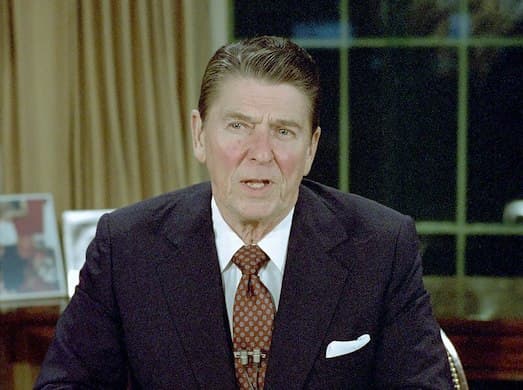Reagan’s Words Ring True as Ukraine Missile Defense Stops Top Russian Weapons
The American president was nearly laughed out of town in the early 1980s when he promoted the Strategic Defense Initiative, widely ridiculed as ‘Star Wars,’ but missile defense is having a big impact on today’s battlefields.

In one of its most successful feats of the war, Ukraine destroyed some of Russia’s top-shelf weapons Tuesday night, boosting President Reagan’s once-ridiculed concept of missile defense.
Kyiv is saying it intercepted six Kinzhal missiles on Tuesday, part of a barrage of projectiles Russia launched at the Ukrainian capital and its environs. Classified as a hypersonic missile, the MiG31-mounted Kinzhal is part of the Russian arms industry’s most prized collection of advanced weapons.
Moscow denies the Tuesday interceptions, but Kyiv residents testify they’ve seen the results with their own eyes. In addition to the Kinzhal missiles, the Russian barrage on Tuesday included Iskander missiles and other projectiles that were shot from the Russia-occupied eastern Ukraine and from Black Sea-based vessels.
The Kremlin says it managed to destroy a battery of an American-made Patriot air defense system, which seems to have been the target of the Tuesday barrage. Citing unidentified Pentagon sources, several news outlets have confirmed the damage to a battery near Kyiv. The national security council spokesman, John Kirby, said that if such damage occurred, America would help Ukraine repair the batteries.
Russia has long sought to present a victory over American air defenses. Yet, an even more politically important statement for the Kremlin was its denial that these defenses worked against Russia’s prized missiles.
The Kinzhal was first introduced to the world in a 2018 speech by President Putin, who boasted of six “next generation” weapons that he said could penetrate any current or future missile defense system. As an intense competition heats up between Mocow, Beijing, and Washington over the development of hypersonic missiles, three Russian scientists in the field were arrested this week on treason charges.
The downing of a half-dozen Kinzhal missiles must be far from reassuring to the already demoralized Russian military. Worse, it could remind Mr. Putin of his oft-expressed pain over the demise of the Soviet Union.
One reason often cited for the Soviet collapse was Moscow’s inability to compete economically with America’s budding missile defense system. In America, Reagan was nearly laughed out of town when he promoted the Strategic Defense Initiative, widely ridiculed as “Star Wars.”
Indeed, at the time the concept, caricatured as “hitting a bullet with a bullet,” was nearly a fantasy unmatched by the period’s technological capabilities. Yet, 40 years later missile defense systems have changed the face of battlefields from Israel to Saudi Arabia to the Korean Peninsula. Now they’re proving crucial in Ukraine.
In 1983, “Star Wars was far more wishful thinking than reality,” an assistant professor of intelligence studies at Mercyhurst University at Erie, Pennsylvania, Fred Hoffman, tells the Sun. Russia and Communist China are now ahead of America in the development of hypersonic missiles, he adds, but, “I think we are more capable in hypersonic missile defense.”
Hypersonic weapons are defined as those that can travel at 5 to 20 Mach. Beyond speed, the challenge they present to defense systems is that unlike ballistic missiles that fly in an arc, some of the more advanced weapons travel in flat trajectories, making them much more difficult to intercept.
The Kinzhal is modeled after the Iskander ballistic missile, and retrofitted to be launched from a fighter jet. “It was built to be an aircraft carrier killer,” a Russia watcher at the Foundation for Defense of Democracies, John Hardie, tells the Sun.
Even as they may not be Russia’s most advanced hypersonic missile, he says, destroying a salvo of six Kinzhals simultaneously is “an achievement, no matter what.” Patriot air defenses were introduced to Ukraine only recently, and its army’s fast integration of the system to its arsenal is impressive, he says.
Earlier this decade, when Moscow and Beijing showcased their weapons of the future, there was a lot of hand-wringing in Washington over America’s inability to catch up in hypersonic missile development.
In its budget request for 2023, the Pentagon asked for $4.7 billion to be allocated for hypersonic research, up from $3.8 billion in its 2022 request. It also requested $225.5 million for hypersonic defense. Both requests are likely to rise next year.
“Hypersonic weapons are extremely difficult to detect and counter given the weapons’ speed and maneuverability, low flight paths, and unpredictable trajectories,” an Air Force general, Glen VanHerck, told the Senate Armed Services subcommittee on strategic forces earlier this month.
During the same hearing, a Navy vice admiral, Jon Hill, noted that missile defense is now based on naval and terrestrial sensors. “Due to the global maneuver capabilities of hypersonic missiles, a space-based tracking and targeting capability is in clear need,” he said.
What is no longer in dispute, and what Tuesday’s battle over Kyiv’s skies shows, is that Reagan was right: Missile defense will prove even more crucial to the battlefield of the future than it seemed when envisioned 40 years ago.

